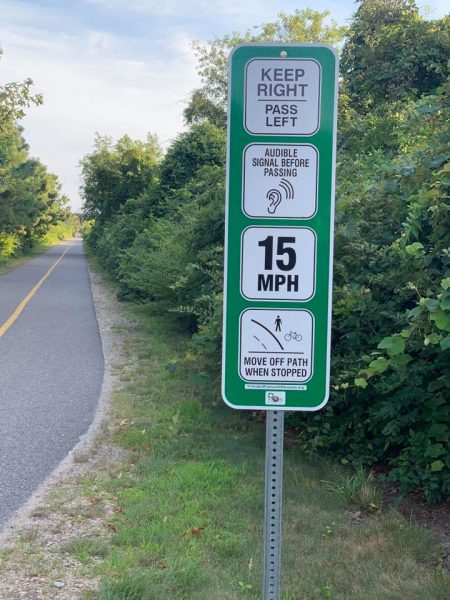The sign in this photo, which I have copied from a Facebook post, is well-intentioned, but it arouses very mixed feelings in me.
I have no sympathy for people who ride at unsafe speeds around other path users, see https://www.youtube.com/watch?v=SD9u01lVxe8. There was a death on the Minuteman path in Lexington, Massachusetts this year resulting from reckless speed and unsafe passing. But when the path is totally empty as shown in the photo, are people to be prevented from riding at a speed which allows them to get any significant fitness benefit, or getting where they want to go when they want to? This is the Shining Sea Path — line of text at the bottom of the sign says “FriendsofFalmouthbBkeways.org“. The alternative is Woods Hole Road, which is not an attractive ride — hilly, not very wide, lots of motor traffic.
Is the 15 mph speed limit supported by law and so enforceable? The southern section of the Shining Sea path, which this appears to be, is controlled by the Town of Falmouth and I found no ordinance establishing a speed limit on it. The speed limit rule in Mass. General Laws applies only to motor vehicles — https://malegislature.gov/Laws/GeneralLaws/PartI/TitleXIV/Chapter90/Section17.
One other thing in the photo is troubling and senselessly restrictive: the solid yellow line in the middle of the path, indicating no passing (and contradicting the “keep right/pass left” sign). Pedestrians use this path, also bicyclists traveling at various speeds. Passing is unavoidable. A long, straight stretch like the one shown should be a passing zone with a dashed yellow line, or none. See https://mutcd.fhwa.dot.gov/htm/2009/part9/part9c.htm
Audible signal before passing is in the law. Moving off the path when stopped is required for courtesy and also covered, see https://malegislature.gov/Laws/GeneralLaws/PartI/TitleXIV/Chapter85/Section11B . But all of the signs except the speed limit sign are nonstandard, that is, they are regulatory signs not tested for effectiveness or approved for use. Pretending that things are law when they aren’t is not right — warning signs (yellow, diamond-shaped) can convey the same message without raising that issue. Senseless and unenforceable restrictions also are not right. These issues could come up in the event of a crash on the path, and could hold a bicyclist at fault, for example, passing safely when someone darts out into the path and there is a collision. But on the other hand, the Friends of Falmouth Bikeways, a private organization, has no authority to post regulatory signs on a public way. So, is there any?


08/28/2019
Response to Street Smarts query about signs on SSBW
The highlighted sign, like others added over the last decade to the Shining Sea Bikeway, was proposed by members of the Falmouth Bikeways Committee, endorsed by that committee which draws its authority from the Town Charter. The Board of Selectmen also were served in considering the signs by endorsement from the Falmouth Traffic Advisory Committee, which has a function similar to the Bikeways Committee: recommending regulatory signs and other traffic control devices.
It should be noted that the Shining Sea is not considered a public way. Rather it is considered a town park and is thus subject to a different set of laws and regulations from a public roadway. While both committees and the Board are aware of the content of MUTCD and Massachusetts law relating to such a thoroughfare, the Town has, on the advice of Counsel, retained that status for the Shining Sea for several reasons which I will not elaborate here.
The Friends of Falmouth Bikeways is a non-profit that assists in embellishing and caring for all bicycling activity in the town. It functions to fund projects after approval by the committees and Select Board. It asserts no authority over signage.